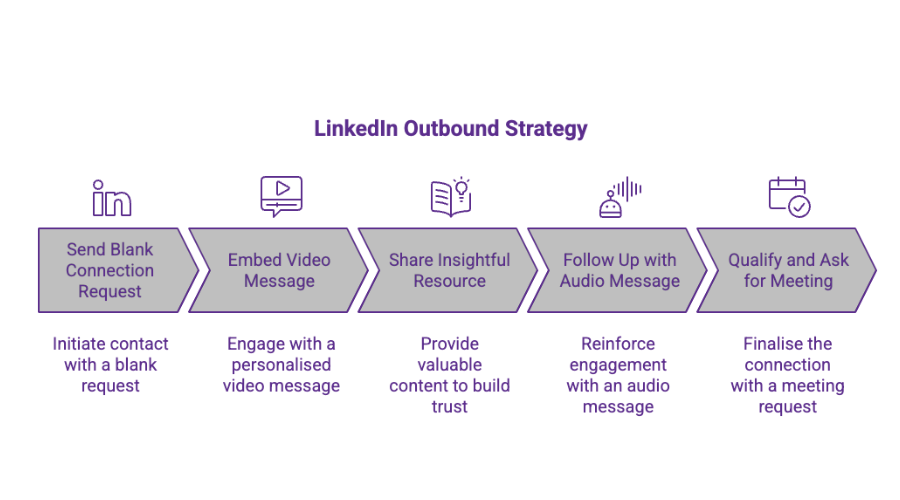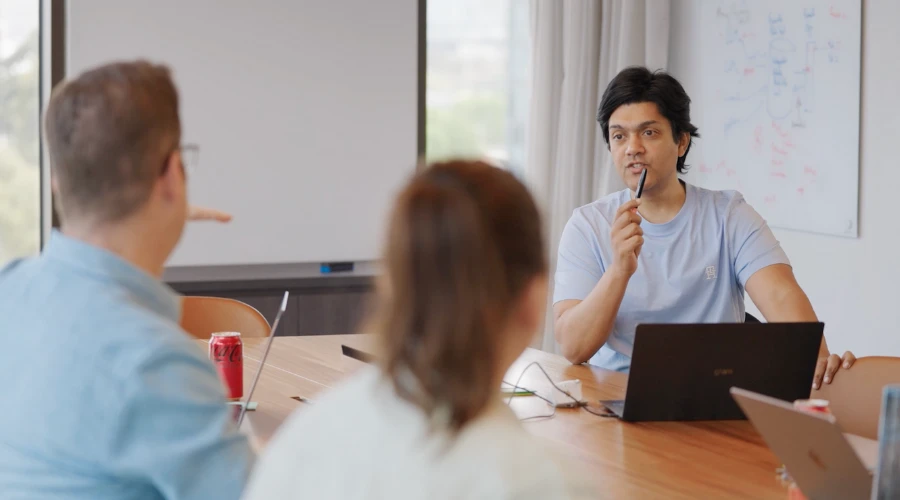LinkedIn outbound strategy: How to book more B2B sales meetings with high-converting outreach
Ramya
on
July 2025

LinkedIn outbound strategy: How to book more B2B sales meetings with high-converting outreach
- July 2025

Let’s be real – if you’re in outbound sales, LinkedIn isn’t optional anymore. It’s where your prospects live, where decisions get made, and where great outreach turns into warm conversations. But most sellers are doing it wrong.
Too many fall into the trap of copy-pasting generic pitches, automating connection requests, or firing off messages like it is cold email 2.0. The result? A burnt network, low conversions, and missed revenue.
In this guide, we break down a proven, data-backed strategy from our “Outbound that converts” webinar – led by advice from Matt Aird, Founder at Sales Science – showing how top-performing reps use LinkedIn as a high-converting outbound engine.
Why LinkedIn deserves its own B2B outbound strategy
LinkedIn sits in a unique space between cold calling and email. It’s more personal than an inbox, but less than a phone call. And while it has tighter activity limits, it offers a goldmine of buyer signals – if you play your cards right.
Here’s why LinkedIn needs its own sales strategy:
- Its rate limited. Unlike email, you can’t blast out hundreds of messages. You typically are allowed up to around 100–150 connection requests a week.
- Your conversation history is permanent. Spam once, and your prospects will remember forever.
- It outperforms email. According to the webinar, LinkedIn conversion rates beat email. And when used well, it complements phone outreach for a multi-touch motion that works.
The modern outbound formula
At its core, outbound success hinges on this simple equation:
Activity × Connect Rate × Conversion Rate = Pipeline
Most sales teams focus too heavily on the activity lever – more calls, more DMs, more emails. But with LinkedIn, the real levers are connect rate and conversion rate.
That’s what the following strategy is all about.
LinkedIn outbound strategy visualised

Step 1: Send blank LinkedIn connection requests (without a note? yes, really)
The first touchpoint on LinkedIn is your connection request – and less is more.
Best practice: Send 90% of your connection requests without a message.
It sounds counterintuitive, but the data backs it up. Here’s how acceptance rates stack up after Matt’s extensive testing:
- Blank request: around 30 percent
- Personalised message: around 21 percent
- Curiosity-driven template: around 30 percent
Why does blank work? Because most automation tools require a message. So, when prospects see one, they often assume it’s a pitch. A blank request feels human – and that’s your edge.
Your job title and tagline don’t have much impact either. A clean profile, relevant connections, and good follow-up matter more.
Step 2: Cut through the noise with an embedded LinkedIn video message
Once you’re connected, don’t start with a pitch. Send a quick video message instead.
Use the LinkedIn mobile app to record or upload a short video directly in the chat. Embedded videos play in-line, unlike links to external platforms like Loom or Vidyard, which often go unopened.
Why embedded video works:
- It plays instantly in the chat
- It cannot be automated, making it rare and authentic
- It shows genuine effort, helping you stand out
Keep the video short – around 30 to 45 seconds – and use it to ask if you can share a resource, not pitch your product.
Step 3: Share an insightful resource (not a product brochure)
Once they’ve seen your video, follow up by sharing something genuinely helpful.
Avoid thinly veiled sales decks or competitor comparisons. Instead, share educational content that sparks curiosity or insight.
This could be:
- Proprietary data from your company
- A one-page industry forecast
- A short market analysis or benchmarking study
- Curated third-party content with your own commentary
What matters is that the resource is relevant, easy to consume, and interesting enough to be shared internally. You’re positioning yourself as a trusted advisor – not a vendor.
In the webinar, a “value-first” approach led to a 28 percent response rate – double that of direct pitch videos.
Step 4: Follow up with an audio message
A few days later, drop a short voice message through the LinkedIn mobile app.
It’s quick, human, and rarely used – which is exactly why it works. While more common than embedded video, audio still stands out compared to text-based follow-ups.
Keep your message under 30 seconds, and ask a simple, specific question. For example:
“Are you planning to train new SDRs internally, or work with an outsourced team?”
This helps you start a conversation without pressure. People are more likely to respond when the ask is clear and easy to answer.
Step 5: Qualify and ask for the meeting
Once you’ve got a response, don’t overcomplicate things. Qualify the lead to confirm they have the problem you solve. If they do – ask for the meeting.
Be clear and confident. Frame your offer to help:
“Sounds like something we’ve helped others with. Want me to show you how it works?”
You don’t need to wait through multiple back-and-forth. If the need is there, move the conversation forward.
Operational best practices for LinkedIn outreach
For B2B sales teams running LinkedIn outreach at scale, structure matters. Here are a few practices that help maintain consistency and performance.
- Use CRM tracking fields Create a field in your CRM (like “LinkedIn validated”) to flag prospects who have connected. These contacts are warmer and can be prioritised for future outreach.
- Batch LinkedIn activity Have SDRs block 45 to 60 minutes per day to focus exclusively on LinkedIn. It builds rhythm and ensures no conversations are missed.
- Respect response cadence Mirror the prospect’s pace. If they take two days to respond, wait two days before following up. It shows empathy and professionalism.
- Review SDR content selectively Some SDRs can write great content. Encourage those reps to share perspectives on LinkedIn – with manager review first. Done well, it builds credibility and accelerates conversations.
Where Firmable fits in
All this hinges on one thing – targeting the right people.
Firmable’s B2B sales intelligence platform helps you build highly targeted lists, track company and contact-level signals, and connect your outreach directly to revenue.
- Access over 1.2 million ANZ companies
- Find verified contact details for over 10 million decision-makers
- Track hiring, growth and funding signals for timing relevance
LinkedIn outreach only works when it’s directed at the right accounts. That’s what Firmable delivers.
Explore our B2B database for LinkedIn prospecting to get started.
Final thoughts
LinkedIn outreach shouldn’t be noisy or transactional. It should feel like a conversation with someone who understands your world.
When you lead with insight, show up like a human, and follow a consistent process – LinkedIn becomes more than a branding tool. It becomes your highest-converting outbound channel.
FAQs on how to create a LinkedIn outbound strategy
The most effective LinkedIn outbound strategy for B2B sales involves sending blank connection requests, following up with embedded video and audio messages, sharing valuable resources, and qualifying leads through personalised follow-ups. This approach helps improve connection and conversion rates while avoiding automation fatigue.
In most cases, it’s better to send a blank connection request without a message. Data shows that blank requests have a higher acceptance rate compared to generic sales messages, as they feel more human and less automated.
LinkedIn typically limits users to 100 ~ 150 new connection requests per week. While some users may be able to push this higher, staying within this range helps maintain quality and avoid account restrictions.
Firmable helps B2B sales teams in Australia and New Zealand identify high-value LinkedIn prospects with verified data, company signals, and contact enrichment. This ensures outreach is targeted, relevant, and conversion focused.
Additional resources


Don't forget to share this post!
You may also like
Learn when and how to reach out to prospects using verified buying signals. Discover proactive sales tips and real-time outreach timing with Firmable.
Blog excerpt: AI voicebots are shaking up outbound sales in the US – but will ANZ buyers trust a synthetic voice? We break down what works (and what backfires), explore key compliance rules, and share why Firmable backs real reps, supported by smart signals.
Join the 2025 ANZ B2B Marketing Leaders Research. Share insights on people, process, and technology. Get early access to the report and a VIP launch invite.
Grow your business faster with Firmable data
With the largest Australian and New Zealand B2B database and the only local support team, it’s easy to get started with Firmable.


